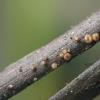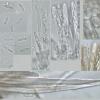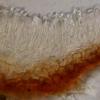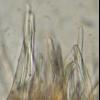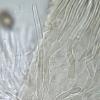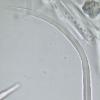
04-01-2026 17:45
 Stephen Martin Mifsud
Stephen Martin Mifsud
I was happy to find these orange asmocyetes which

03-01-2026 13:08
Niek SchrierHi all,We found groups of perithecia on a Lecanora

29-12-2025 17:44
Isabelle CharissouBonjour,J'aimerais savoir si d'autres personnes au

02-01-2026 17:43
MARICEL PATINOHi there, although I couldn't see the fruitbody, I

01-01-2026 18:35
Original loamy soil aside a artificial lake.The co

31-12-2025 19:27
Collected from loamy soil, at waterside (completel
Hyalopeziza or Urceolella?
Uwe Lindemann,
10-03-2009 11:24
three days ago I found a little brown discomycet on needles of Pinus nigra. First I think of Hyalopeziza (Urceolella) trichodea, but the ascospores are too great. Here some data of the micoscorpic features:
- Asci 8-spored, with crozier, IKI-, biserat: 37-46 x 4,3-5,2
- Paraphyses, cylindrical, 2-3 septate
- Ascospores: hyaline, with two oder more guttules: (7,5)8-10 x 2-2,6
- Ectales excipulum: brown, textura prismatica
- Hairs, cylindrical, pointed, brown, with thick walls, aseptate: 120-135 x 4-6
I hope that you can help me.
Uwe
Hans-Otto Baral,
10-03-2009 13:43

Re:Hyalopeziza or Urceolella?
Hallo Uwe
this is a hard nut! I assume you found it in Central Europe? I do not know H. trichodea very well but it seems it has eguttulate smaller spores. From your photos I would describe the hairs and excipulum as pale brownish. I only know a few collections on Rosaceae branches from N-America (Amelanchier) and Spain (Rosa) with similar characters, but wider spores (6-10 x 2.8-4) and shorter hairs (40-75 µm). They are on the DVD: 5731g, 5482e, 8056e, in dir. Unguiculariopsis, though the hairs are not curved above. What you could do is to mount the hairs in 5-10% KOH to see whether the glass is soluble (to exclude Urceolella).
Zotto
this is a hard nut! I assume you found it in Central Europe? I do not know H. trichodea very well but it seems it has eguttulate smaller spores. From your photos I would describe the hairs and excipulum as pale brownish. I only know a few collections on Rosaceae branches from N-America (Amelanchier) and Spain (Rosa) with similar characters, but wider spores (6-10 x 2.8-4) and shorter hairs (40-75 µm). They are on the DVD: 5731g, 5482e, 8056e, in dir. Unguiculariopsis, though the hairs are not curved above. What you could do is to mount the hairs in 5-10% KOH to see whether the glass is soluble (to exclude Urceolella).
Zotto
Uwe Lindemann,
10-03-2009 15:02
Re:Hyalopeziza or Urceolella?
Hello Zotto,
Yes, I found it in Central Europe, more precisely at Herten (Halde Hoheward) in a young plantation of Pinus nigra. There is a little problem: I have only KOH 3%. It is perhaps too weak to prove wether the glass in the hairs is soluble. I'll later prove it and I hope something will happen...
I cannot find HB 8056e on your DVD. HB 5731g and HB 5482e seems very similar to my collection. So it is maybe Unguiculariopsis and not Hyalopeziza or Urceolella. Thank you for your interesting remarks!
Uwe
Yes, I found it in Central Europe, more precisely at Herten (Halde Hoheward) in a young plantation of Pinus nigra. There is a little problem: I have only KOH 3%. It is perhaps too weak to prove wether the glass in the hairs is soluble. I'll later prove it and I hope something will happen...
I cannot find HB 8056e on your DVD. HB 5731g and HB 5482e seems very similar to my collection. So it is maybe Unguiculariopsis and not Hyalopeziza or Urceolella. Thank you for your interesting remarks!
Uwe
Hans-Otto Baral,
10-03-2009 16:33

Re:Hyalopeziza or Urceolella?
Hi Uwe
3% KOH is enough if you heat the slide over a flame until it boils and some water evaporates. Then you get a clear result.
It is only an idea to put these in Ungioculariposis where solid glassy hairs also occur. Sorry, 8056e is too new to be on the DVD. here some images of that.
3% KOH is enough if you heat the slide over a flame until it boils and some water evaporates. Then you get a clear result.
It is only an idea to put these in Ungioculariposis where solid glassy hairs also occur. Sorry, 8056e is too new to be on the DVD. here some images of that.
Hans-Otto Baral,
10-03-2009 16:36

Re:Hyalopeziza or Urceolella?
Arizona, Grand Canyon Village, Amelanchier branch.
Data: Ap. rehydr 0.25-0.7 mm diam. Asci KOH 33-42 x 7-8.5 µm, 8sp., apex hemisph., without dome. Sp. *6-10.5 x (3.3-)3.7-4 µm, (1-)2 large LBs, ovoid-ellipsoid-oblong. Hairs 30-75 x 3-4 µm, apically only slightly tapering, straight, wall near base 0.8-1.2 µm thick, towards apex thin-walled, aseptate. Paraphyses covered by very distinct gel matrix. Ectexc. light rustbrown thin-walled t. angularis, KOH unchanged, not dissolved.
Zotto
Data: Ap. rehydr 0.25-0.7 mm diam. Asci KOH 33-42 x 7-8.5 µm, 8sp., apex hemisph., without dome. Sp. *6-10.5 x (3.3-)3.7-4 µm, (1-)2 large LBs, ovoid-ellipsoid-oblong. Hairs 30-75 x 3-4 µm, apically only slightly tapering, straight, wall near base 0.8-1.2 µm thick, towards apex thin-walled, aseptate. Paraphyses covered by very distinct gel matrix. Ectexc. light rustbrown thin-walled t. angularis, KOH unchanged, not dissolved.
Zotto
Hans-Otto Baral,
10-03-2009 16:36
Stip Helleman,
10-03-2009 16:54

Re:Hyalopeziza or Urceolella?
Hello Uwe & Zotto,
If KOH does not work, try Congo Red, this test was used by Ain Raitviir. In Hyalopeziza the hairs should react positive (strong to faintly) in Urceolella negative.
I would put the Amelanchier species also in Unguiculariopsis although the hairs are not curved, the excipulur structure looks more like it
Cheers Stip
If KOH does not work, try Congo Red, this test was used by Ain Raitviir. In Hyalopeziza the hairs should react positive (strong to faintly) in Urceolella negative.
I would put the Amelanchier species also in Unguiculariopsis although the hairs are not curved, the excipulur structure looks more like it
Cheers Stip
Hans-Otto Baral,
10-03-2009 17:53

Re:Hyalopeziza or Urceolella?
Hei, I was unaware of that CR reaction. Should be tested routinely!
Zotto
Zotto
Uwe Lindemann,
10-03-2009 21:47
Stip Helleman,
11-03-2009 07:08

Re:Hyalopeziza or Urceolella?
Hello Uwe,
In contrary it means that it is a Hyalopeziza! But it is still puzzling becouse you never know in which genus this species is describd (if it is...).
I will keep this in mind.
cheers Stip
In contrary it means that it is a Hyalopeziza! But it is still puzzling becouse you never know in which genus this species is describd (if it is...).
I will keep this in mind.
cheers Stip
Hans-Otto Baral,
11-03-2009 08:32

Re:Hyalopeziza or Urceolella?
I still did not find my brief drawing of the only collection of Hyalopeziza trichodea I have seen. With your new photos I think in the meantime, that it should be this species. Perhaps the spores are given too small in the literature because of the shrinking effect.
Zotto
Zotto
Uwe Lindemann,
11-03-2009 09:29
Re:Hyalopeziza or Urceolella?
Hello Stip & Zotto,
yes, Stip, you are right - Hyalopeziza, not Urceolella. I confounded it.
And if it is Hyalopeziza trichodea the shrinking effect is great. In Ellis/Ellis 1997 the ascopores are 6-7 x 1,5, in Raitviir 2004 4,5-7 x 1,5, in my own collection (7,5)8-10 x 2-2,6, but all other microscopic features are fitting well for H. trichodea.
Thank you both very much for your help!
Uwe
yes, Stip, you are right - Hyalopeziza, not Urceolella. I confounded it.
And if it is Hyalopeziza trichodea the shrinking effect is great. In Ellis/Ellis 1997 the ascopores are 6-7 x 1,5, in Raitviir 2004 4,5-7 x 1,5, in my own collection (7,5)8-10 x 2-2,6, but all other microscopic features are fitting well for H. trichodea.
Thank you both very much for your help!
Uwe



